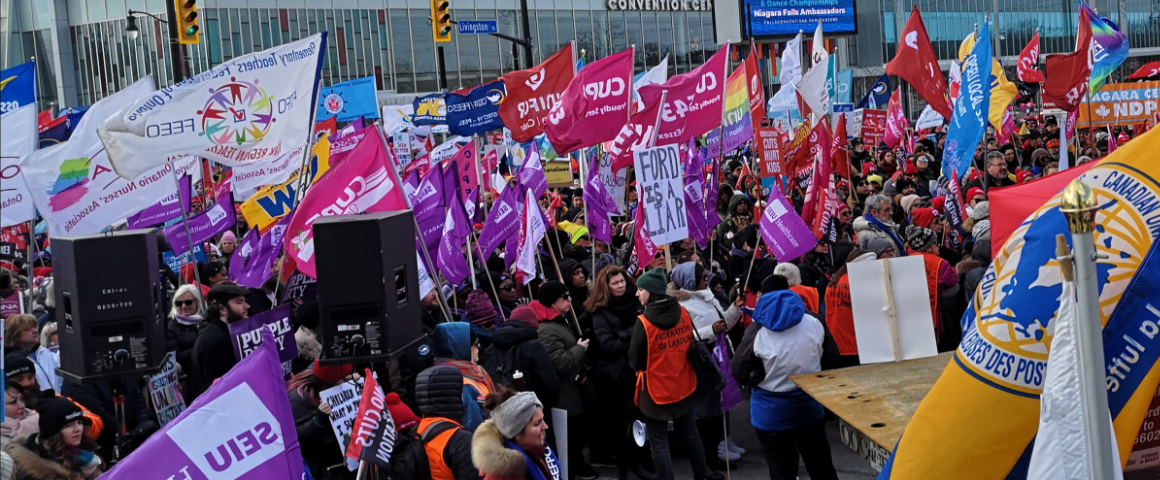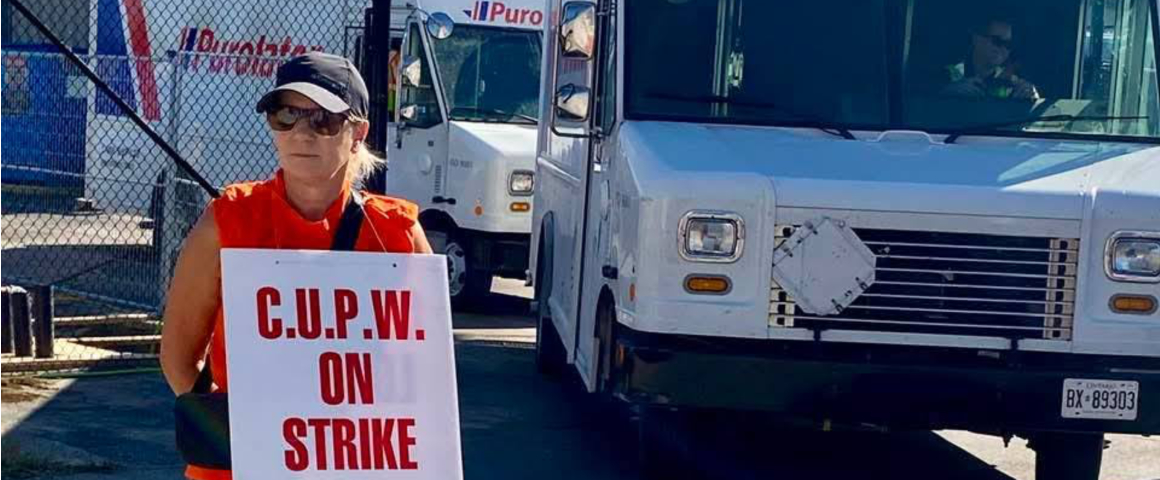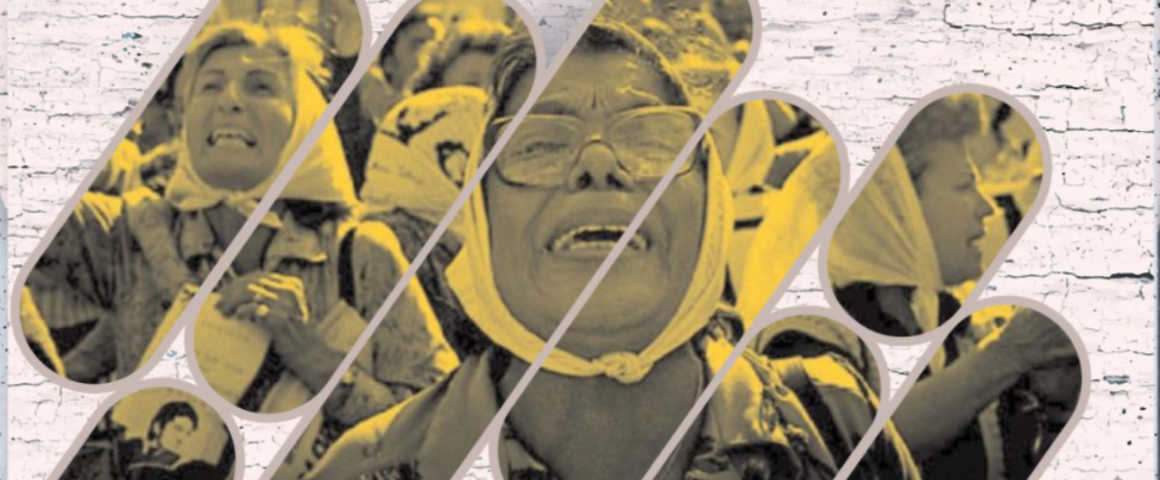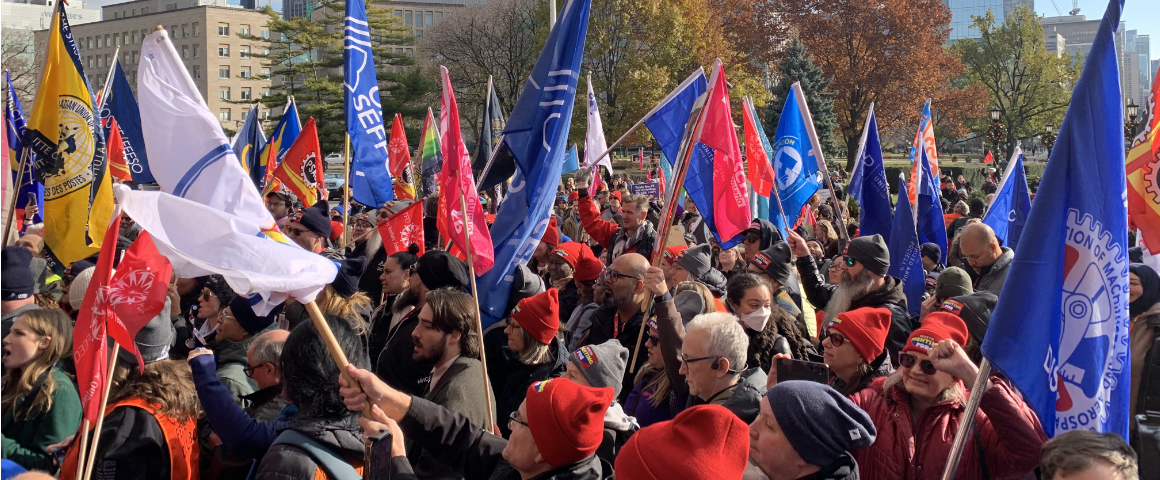PV Labour Bureau
As far back as the 16th century, people said “you can lead a horse to water, but you can’t make it drink.” When it comes to the working class in Ontario, labour leadership has been led many times to the rivers of class struggle over the recent past, but it has consistently refused to partake.
Soon after Doug Ford’s Conservatives won the June 2018 provincial election, sections of the working class and people’s movements moved into action. The Fight for $15 and Fairness campaign initiated a Day of Action in October of that year, to defend recently won minimum wage increases and employment standards reforms. While the Ontario Federation of Labour (OFL) and a few provincial affiliates managed to mobilize some of their membership for this rally, the labour leadership declined to take the reins and build the struggle into an escalating campaign of resistance to the severe neoliberal austerity that everyone knew was coming.
A few months later, Ford’s April 2019 “Open for Business” budget – capping a year of spending cuts to health, education and social programs, deregulation and privatization, and tax cuts for corporations and the rich – set off another storm of labour protest. In the lead-up to the budget, education unions organized a mass rally that brought out tens of thousands of teachers and education workers, students, parents and community members. This action was bolstered by the estimated 100,000 elementary and high school students that walked out of their schools two days prior.
Shortly after, the Ontario Health Coalition organized a massive protest of at least 10,000 people to oppose healthcare cuts and privatization. These mobilizations and others were strong enough to force Doug Ford into hiding during the 2019 federal election campaign, as his plummeting popularity helped to isolate and block the federal Conservatives from gaining traction in Ontario.
Yet, despite this abundant proof that mass resistance was possible and effective against the Ford government, the OFL (then under Chris Buckley’s leadership) continued to sit on its hands, and the hands of the working class as a whole. The “Power of Many” campaign – which many hoped would lead an escalating labour-community resistance like the Days of Action against the Mike Harris government – quickly became a method of “branding” and managing actions and statements against Ford, and actually blocked other coalitions that might have emerged.
The 2019 OFL Convention, which took place in the middle of the teachers’ and education workers’ struggle, hinted at signs of limited movement in the right direction. On the one hand, the action plan called for strengthening the “Power of Many” campaign to oppose Ford. On the other hand, much of the plan focused on building labour’s capacity in “swing-ridings” and recruiting volunteers for the NDP’s election campaign in 2022, a full three years down the road.
The leadership election in 2019 was similarly mixed. The convention’s election of Patty Coates as president paved the way for continued stagnation of the OFL that set in after affiliate leaders conspired to remove the social unionist-oriented leadership of Sid Ryan in 2015. However, the convention also elected long-time social unionist and activist, Janice Folk-Dawson as Executive Vice President. Her presence has helped the OFL leadership take a somewhat more engaged role in the fightback since the Buckley years, with more regular participation in actions supporting Indigenous movements, migrant worker organizing and anti-racist movements.
The high point of labour resistance to Ford was the escalating struggle by teachers and education workers, culminating in the coordinated strike by close to 200,000 on February 21, 2020. This was supported by the kind of strong labour-community alliance which will also lead to a growth in unionization as respect for the labour movement increases. Riding this momentum, the OFL organized its first (and so far, only) mass demonstration against the government on February 22, when 5000 union and community members protested the Conservatives’ conference in Niagara Falls.
Here again, though, the labour leadership backed down and failed to build the working-class movement. Without a doubt, calls for any mass action were severely compromised by pandemic lockdown measures introduced in March 2020. But the decisive factor is that, well before the pandemic, the OFL and major affiliates had simply not committed to organizing and leading the broad mobilization that workers desperately need.
This “duck and cover” tactic is exemplified by the one “campaign” that the OFL has continued since Ford’s election: the provincial election countdown clock on its website. In the absence of a fighting leadership, the clock is little more than a grim reminder to Ontario workers of how long they must suffer under Doug Ford.
The OFL has recently doubled down on this electoralist approach, with a mass email campaign that offers workers the opportunity to sign up for a “reminder to vote” before the next provincial election. As if we are likely to forget…
The draft Action Plan for the 2021 OFL Convention is entirely focused on the election. Right off the top, it declares that “the explicit goal of our campaign is to defeat Doug Ford’s anti-worker government in the next provincial election, by electing a workers-first majority government led by the New Democratic Party.” In the 17 pages that follow, there are no less than 70 references to the NDP.
Is defeating Ford in the next election critical? Yes, of course it is. His government represents the most aggressive attack by capital in recent memory, and defeating it is key for the working class to move from the defensive to the offensive.
But simply “unelecting” Ford is not enough – we need to defeat the entire agenda of neoliberal austerity. That requires a sustained, progressive mass campaign by labour and its allies, led by the trade union movement and united around a radical program based on working-class demands. Despite its talk about extra-parliamentary action, the labour leadership has consistently avoided this responsibility and outsourced virtually all of its political work to the NDP (in the main) and a handful of coalitions. Typically, the OFL’s best policy demands (such as $20 minimum wage) are left as preambles in the Action Plan and receive no commitment of resources for building on the ground.
In reaction to such opportunism and collaborationism, the ultraleft in the labour movement has seized the mic, so to speak, and its “leadership slate” repeatedly calls for immediate and unlimited general strikes. Of course, the political strike weapon is critical. But as we know from the 1976 National Day of Protest and the 1996 Metro Days of Action, even a one-day general strike requires months of outreach, engagement and organization. Reducing class struggle to empty sloganeering and rhetoric is a failed tactic that isolates the left from the mass of the labour movement and allows the right wing to consolidate itself by masquerading as a credible alternative.
Ironically, many on the sectarian ultraleft and the opportunist right agree about providing unconditional support to the NDP, putting all the working class’s eggs into one basket that is woven from a single election, a single outside player.
The draft Action Plan correctly notes: “On its own, no political party can implement the kind of change we need without a movement behind it, constantly pushing it forward and holding it to account.” Yet, the document fails to deliver even a sketch of a plan for building such a movement, by putting labour’s own massive shoulder to the wheel. Instead, it immediately reverts to preparations for the NDP’s election campaign. The NDP will determine NDP policy. But only labour can determine labour policy, and it must do that now and organize around it. If candidates (NDP, Communist or others) meet that bar during an election, they deserve labour’s endorsement – but that must be earned, not taken for granted.
As President of the Guelph Labour Council, Folk-Dawson led an effort to develop a minimum political program for labour, to which election candidates were asked to commit. It may appear a modest step, but it is an important move away from the approach of labour bodies which have been content to either opportunistically endorse whoever could defeat the right-wing, or lazily provide blanket support to the NDP. In working to bring this and other social unionist approaches to the OFL, Folk-Dawson is a rare bright spot among the labour leadership and deserves to be re-elected.
As is always the case in the class struggle, there are many other signs of life in the Ontario labour movement. Gig workers continue to organize with the support of trade unions, most notably the Canadian Union of Postal Workers, and precariously employed workers are mobilizing and some have taken strike action. Healthcare workers are taking action, including strikes, to demand better wages and working conditions from governments and employers who have denied the same while hypocritically commending their work during the pandemic. Manufacturing workers like those at Rexplas – mostly racialized, immigrant women – have stood firm against powerful corporate employers to fight for and win wage and benefit gains.
These and many other examples provide the basis for a turnaround in the Ontario labour movement, but it needs to happen soon. Like the proverbial horse, if the OFL continues to refuse to drink it will die of thirst, a dried out flaking shell of what was and what could have been.
As the OFL Convention meets, labour and the working class are at this crossroads. The class struggle will continue either way, but it will be much better if the labour leadership is part of it.




